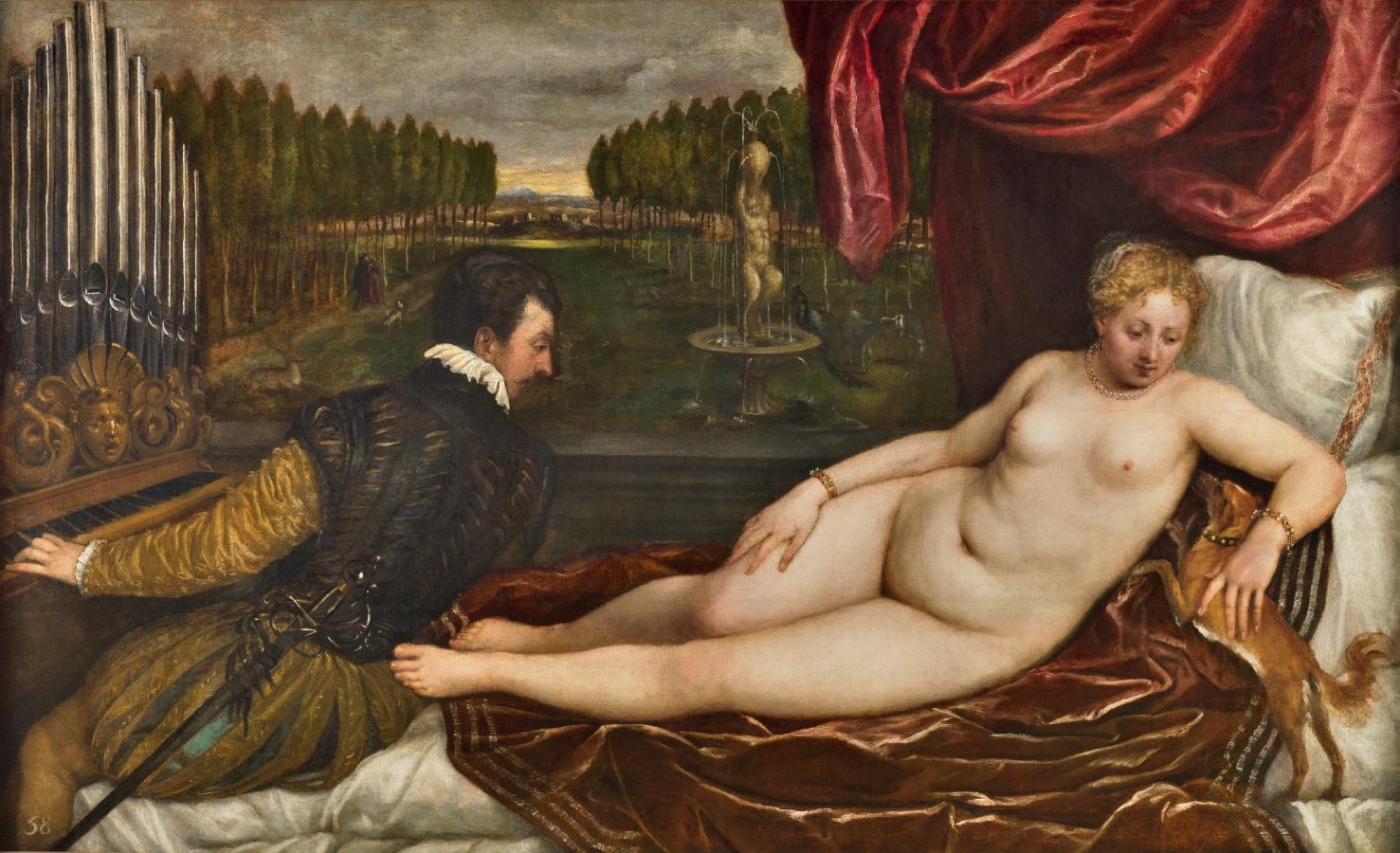Tiziano (c.1488-1576)
Venere con organista e cagnolino (Venus with an Organist and a Little Dog)
c.1550
Oil on canvas, 138 x 222.4 x 3.5 cm
Museo del Prado, Madrid
In contrast to the paintings created for the Camerino d’Alabastro and the poesie made for Philip II, the canvases on the subject of Venus do not form a homogenous group as they were not painted for one client, nor were they designed to be shown together. In fact, the five paintings on this subject are variations on one idea. Located in a villa on the Venetian terra ferma, they depict Venus reclining before a large window. At her feet is an organist (Madrid, Prado and Berlin, Gemaldegalerie), or a lute player (New York, Metropolitan Museum, and Cambridge, Fitzwilliam Museum) playing their instruments while they contemplate the goddess in her nudity -slightly concealed by a gauze covering the pubic area in the three versions not in the Prado. She looks away, distracted by the presence of a lap dog or a Cupid. These paintings can be seen as the final stage in the development of a sub-genre, that of the reclining Venus, started with the Giorgione/Titian Sleeping Venus, continued with The Venus of Urbino, and a lost origfinal (perhaps the Venus sent to Charles V in 1545), from which derived the Venus and Cupid (Florence, Uffizi), the immediate precedent of the so-called Venus and Musician canvases. The paintings of Venus with a musician have been the subject of various interpretations. For some art historians (from Middeldorf to Hope) they are clearly erotic works lacking any more profound meaning; for others (Brendel, Panofsky, and more recently Rosand and Goffen), they have a considerable symbolic content and have been interpreted as allegories of the senses from a Neo-platonic perspective, with sight and hearing as the instruments to gain a knowledge of beauty and harmony, as proposed by Mario Equicola among others in his Libro di natura d’amore (Venice, 1526). It is, however, risky to read all these paintings in exactly the same way without bearing in mind the commercial logic prevailing in Titian‘s studio, in addition to the particular circumstances which lay behind the creation of each canvas. The Venus no. 420 was painted within a matrimonial context. This is suggested by the fact that it is the only one of the five compositions in which both figures have individualised features. Those of the Venus in Prado no. 421 reappear in the Venus with an Organist in Berlin and the Tarquin and Lucretia, among other works. Furthermore, in no. 420 the woman is clearly wearing a wedding ring on her right hand and has no attributes which would identify her as Venus, as she is the only one not accompanied by Cupid. Finally, the figures in the garden (unique in Titian‘s oeuvre and for Dolce a metaphor of a happy marriage), here acquire a marital meaning: the dog alluding to fidelity, the donkey to eternal love and the peacock to fecundity. A technical analysis of the paintings confirms the prime status of the Venus and Music (P420). The overall handling and certain formal and conceptual aspects, such as the arrangement of a nude reclining figure opposite another seated one, place it close in date to the second Danaë (P425). X-radiographs allow us to reconstruct the changes Titian made during the work´s execution. His first idea was notably more daring, with the woman in abandonment on the bed, her gaze meeting that of the musician. The client or the artist himself must have considered such a pose too provocative and changed the woman’s head to look towards a lap dog which was added, replacing the initial exchange of gazes and relegating the woman to a passive role, the mere recipient of the gazes of her companion and of the viewer. Venus and Music belonged to the lawyer Francesco Assonica. Around 1622 it was still in Venice, where it was copied by Van Dyck in his Italian Sketchbook (folio III). It was later acquired by Charles I of England. After his death Philip IV bought it, and it is inventoried in the Alcázar in Madrid between 1666 and 1734. During the eighteenth century it hung in the Palacio Real Nuevo, entering the Museo del Prado in 1827. (Falomir Faus, Miguel, Tiziano, Madrid, Museo Nacional del Prado, 2003, p.248-251)
